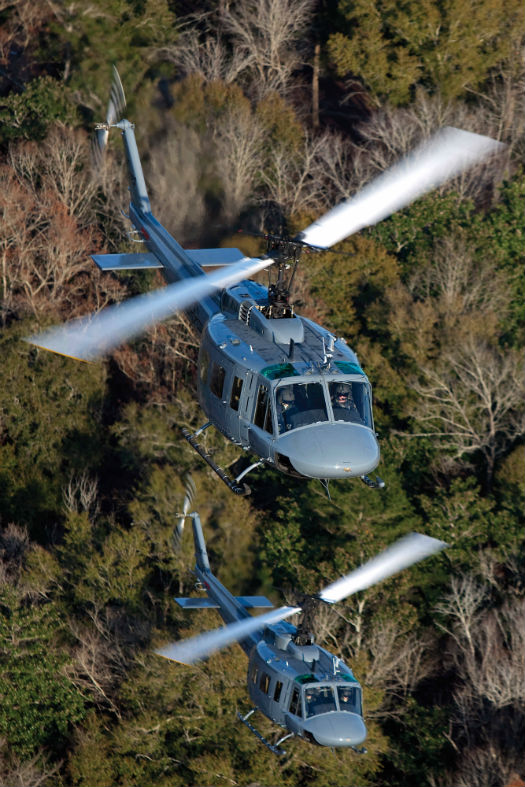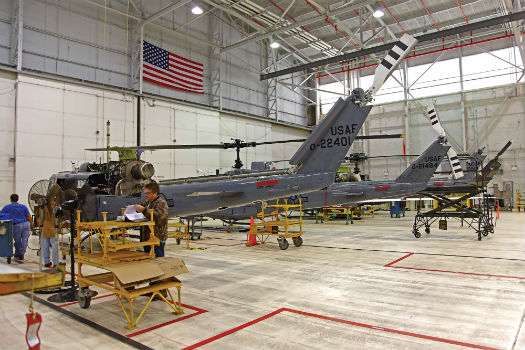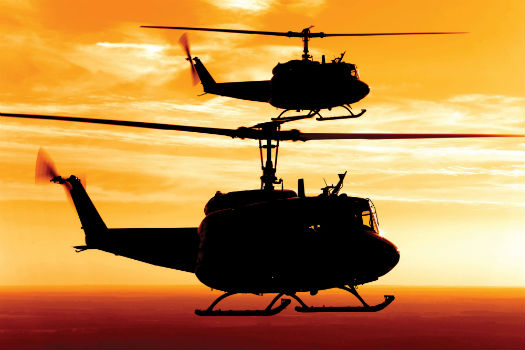
The Vietnam-era Huey refuses to disappear into the sunset, continuing to find a useful role in a 21st century U.S. military. Ted Carlson Photos
The United States Air Force (USAF) has operated several versions of the famous Bell UH-1 Iroquois “Huey” since the iconic helicopter’s operational introduction during the Vietnam War. The newest kid on the Air Force’s block is the TH-1H, which is operated by Air Education and Training Command’s (AETC’s) 23rd Flying Training Squadron (FTS), a geographically separated unit of the 58th Special Operations Wing.
Based at Cairns Army Airfield at Fort Rucker, Ala., the 23rd FTS has an official mission statement of “Training tomorrow’s warriors.” It conducts specialized undergraduate helicopter pilot training, and is the USAF’s primary source of helicopter pilots for special operations, combat search and rescue, missile support, and distinguished visitor airlift missions.
The TH-1H, which was given the “TH” (training helicopter) designation due to its specific role, joined the squadron’s fleet in November 2005, and includes significant upgrades derived from its successful predecessor — the twin-engine UH-1N.
A whole new Huey
The Air Force’s TH-1Hs were converted from U.S. Army UH-1Hs, with the work completed by US Helicopter (now known as the Military Aircraft Overhaul Center) in Ozark, Ala. After the Army transferred ownership of the aircraft in October 2004, the aircraft were completely gutted down to the “hulk” — the cabin frame less external skin.
From there, everything added back into the aircraft was brand new – from the tail boom, to the engines, gearbox, avionics, instruments, and controls. (But since the aircraft started with the UH-1H cabin, they retained the 1970s vintage serial numbers.)

While the U.S. Marine Corps has brand new Bell UH-1Y “Yankee” models, the U.S. Air Force operates the Bell TH-1H training models seen here. The Huey design was first on the drawing board over 60 years ago and will soldier on for decades longer.
While the TH-1H is similar enough to its civilian Huey II counterpart to loosely inherit the “Huey II” moniker (although many of the crews simply call it the “TH”), the two differ substantially in their avionics — and it was the need for updated avionics that was highlighted in particular by the USAF, since the majority of its aircraft now have glass cockpits. Unlike the UH-1H, the TH has identical instrumentation on both the pilot and copilot stations, with a trio of multifunction displays (MFDs) in a fully night vision goggle (NVG) -compatible cockpit. This aims to both reduce the learning curve for the student pilots and ease their transition into the cockpits of the aircraft they will ultimately be flying operationally.
Another change from the UH-1H is the engine; the TH has the more powerful Honeywell T53-L-703 (the same as used in the Bell AH-1F Cobra), which increases its gross weight limit to 10,500 pounds as compared to the UH-1H’s 9,500 pounds.
The TH also has a single hydraulic system, larger diameter skid cross beams, and a longer tail boom. The tail rotor itself is located on the opposite side of the tail to the UH-1H (aerodynamically this exerts a tractor pull — allowing for better pedal turning authority for the pilot). The main rotor is a high-inertia system, with a larger diameter drive shaft and wider blades. A final noticeable airframe adjustment is in front of the cockpit — the TH has the longer N-model style nose in order to house the increased avionics.

Formation training is an important component of the USAF TH-1H syllabus. The aircraft are all painted a glossy gray.
Training in Phases
The 23rd FTS processes about 60 to 70 new pilots each year, but has the capability to graduate more if required.
“The TH is a great training helicopter,” said Captain Wyeth Lindeke, a former TH instructor pilot with around 1,000 hours of military flight time. “We can build routes in the GPS that are displayed on the MFDs, showing waypoints and the line route navigation, with a helicopter icon representing the present location.”
Some of the skill sets taught at the unit include transition maneuvers; emergency procedures; instrument procedures; visual flight rules (VFR) navigation; NVG flight; and remote, low level, and formation operations. The weather at Fort Rucker usually produces a low density altitude that enhances power margins, making life easier for students while they learn the various skills.
While training new pilots is the unit’s primary role, its secondary role is running Introduction to Rotary Wing Fundamentals (IRWF) — a five-month conversion course for those who already have their wings (fixed-wing pilots). The unit also has a Pilot Instructor Training Program for instructor pilots. The remainder of its training is for students who are already experienced helicopter pilots, but do not fall under AETC (such as special operations or test pilots), who come to the unit for a TH checkout only.
Typical TH training sorties see two students accompany an instructor for the flight. The instructor sits in the left seat, with one student in the right seat, and the other student in the jump seat. They land halfway through the sortie to get fuel, and the students swap positions. In effect, every instructor is “double turning” and gets two missions out of one flight. The method also benefits the students, who get to observe their counterpart flying and learn from the other’s mistakes.

Unlike its UH-1H and UH-1N predecessors, the TH-1H has a modern glass cockpit. This eases a student’s transition into their operational aircraft assignment, where glass cockpits are used widely.
USAF helicopter training differs from Army and Marine Corps helicopter training in that, while the other services primarily train for their mission to be in support of the troops on the ground, the Air Force trains for special operations, CSAR (combat search and rescue), and distinguished visitor support. Often these types of missions involve deep penetration into hostile areas and the training for that is of a broader spectrum.
Lindeke said it is undertaken in distinct phases. First is the contact phase, where civilian URS instructors — many of whom are retired Army or Air Force pilots — go to a local stage field with the student and cover basic normal approaches, landings, and takeoffs. The students then cover steep approaches and landings, before practicing emergency procedures, autorotations, and potential problems with hydraulic system. Students then move to the remote phase.
“They transition to unimproved landing areas, stay high, then land in [the] landing zone . . . judging closure rates using points of references,” said Lindeke.
Next is the instrument phase, during which students perform full dynamic simulator work, and then complete instrument flights in the aircraft.
Lastly comes the tactical phase. This begins with low-level day flights, first as a single-ship, and then in formation. NVG work rounds out the training, with nighttime remote landings and night tactics.
Upon graduation, the student typically leaves the 23rd for their operational unit with around 35 simulator hours and 100 flight hours in the TH.

The ramp at Fort Rucker is a busy place. TH-1Hs share their area with the U.S. Army orange-and-white Bell TH-67A Creek trainers (based on the Bell 206).
A history of success
The 23rd FTS is located at an Army base, operationally reports to Kirtland Air Force Base (AFB), N.M., and has its administrative items such as leave, medical, and finances, handled by Tyndall AFB, Fla. This presents the unit with some fairly unique challenges.
“Having three different entities to operate under is different and can be a bit of a juggling act,” said Lindeke. “The Air Force rotates instructors for each student, whereas [with] the Army method, a student is assigned to an instructor and remains with that one individual. The Army tends to have more specialized instructors for certain areas, while the Air Force instructors are more well-rounded in all areas, and may also spend more time on the mission management aspect.”
The unit’s washout rate is extremely low, which perhaps speaks to the method of instruction employed during training. Several different instructors may be used to enlighten students via different approaches and techniques, some students may need more one-on-one time, or perhaps need to repeat some flights. The Instructors will make sure the students fully understand everything before they fly, and will go out of their way to drive a point home that helps the student.

New TH-1Hs on the assembly line are prepared for delivery. “Huey IIs” have been very successful in carrying on the Huey legacy.
After the students graduate, they are winged and go to Kirtland AFB for further training in their mission helicopter — the UH-1N Huey, the Sikorsky HH-60G Pave Hawk, or the Bell-Boeing CV-22 Osprey. If selected for the Osprey, students are routed through Marine Corps Air Station New River, N.C., and perform initial training using Marine Corps aircraft. There are also a few Air Force V-22 instructors at New River.
Taking off with the “TH”
The TH-1H continues to evolve. Last year it received a rotor brake; and flight engineer instructors, along with flight engineer students, began training with the 23rd FTS in April 2013.
The unit has now received 28 TH-1Hs. Minor ongoing sustainment items for the aircraft include upgrading the oil system, taking out keys, and adding fuel switch protectors.
While the UH-1H Huey was a stellar workhorse and an excellent trainer for the Air Force, the Vietnam-era helicopter had become tired and the time has come to put it out to pasture. The TH-1H gives the 23rd FTS a contemporary asset to train with, providing the next generation of USAF pilots with a better platform from which to launch their flying careers.
Ted Carlson is a professional aviation photojournalist and runs Southern California-based Fotodynamics.com. He specializes in aerial photography of military and civil aircraft, and his images have adorned over 300 covers of various publications. As a writer, Ted has hundreds of his articles published worldwide. He can be reached at: fotodynamics@cox.net





